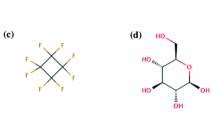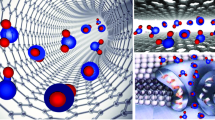Abstract
Simple analytical expressions for calculating the radii of atoms of most of the elements in the Periodic Table and the molecule of liquid water were obtained. The molecular structure of liquid water is a mixture of closely packed single molecules and clusters whose quantitative ratio is a function of the temperature. At a water temperature of approximately 39°C, the radius of the water molecule is close or equal to the radius of the deep hole formed by (H2O)5 clusters, which minimizes variation of the coefficient of thermal expansion, while the isothermal compressibility factor attains the minimum in a wide range of pressures. a cluster:single molecule ratio of 1:8 is then attained. The threshold value of the temperature of ice formation of supercooled water is approximately −16°C.
Similar content being viewed by others
References
A. V. Skolunov,Zh. Fiz. Khim.,73, No. 9, 598 (1999).
A. V. Skolunov,Khim. Volokna, No. 3, 15 (1997).
A. V. Skolunov,Khim. Volokna, No. 6, 25 (1997).
N. Maeno,The Science of Ice [Russian translation], Mir, Moscow (1988).
Yu. G. Bushuev and A. K. Lyashchenko,Zh. Fiz. Khim.,70, No. 3, 416 (1966).
A. Wallqvist and P. O. Astrand,J. Chem. Phys.,102 (16), 6559 (1995).
D. Eisenberg and W. Kauzmann,The Structure and Properties of Water, Oxford University Press, London (1969).
Sotiris S. Xantheas and Thom H. Dunning,J. Chem. Phys.,99(11), 8774 (1993).
F. Sigon, A. Servida, and A. E. Galashev,Zh. Strukt. Khim.,37, No. 2, 299 (1996).
A. V. Skolunov,Elektrokhimiya,27, No. 8, 969 (1991).
A. V. Skolunov,Khim. Volokna, No. 1, 21 (1999).
A. V. Skolunov,Khim. Volokna, No. 6, 44 (1998).
Linus Pauling and Peter Pauling,Chemistry, W. H. Freeman, San Francisco (1975).
A. G. Lipson and V. A. Kuznetsov,Zh. Fiz. Khim.,70, No. 9, 1718 (1996).
Chemist's Handbook [in Russian], Vol. 1, Goskhimizdat, Leningrad-Moscow (1963).
V. S. Dunyashev, Yu. G. Bushuev, and A. K. Layshchenko,Zh. Fiz. Khim.,70, No. 3, 422 (1996).
A. H. Narten,J. Chem. Phys.,56, 5681 (1972).
J. H. Conway and N. J. A. Sloane,Sphere Packings, Lattices and Groups, Springer-Verlag, New York (1988).
John Emsley,The Elements, 2nd ed., Clarendon Press, Oxford (1991).
R. A. Lidin, V. A. Molochko, and L. L. Andreeva,Chemical Properties of Inorganic Substances [in Russian], Khimiya, Moscow (1996).
Additional information
UVIKOM, Mytishchi. Translated fromKhimicheskie Volokna, No. 6, pp. 25–29, November–December, 1999.
Rights and permissions
About this article
Cite this article
Skolunov, A.V. Some characteristics of liquid water described with a cluster-hydroscopic model. Fibre Chem 31, 441–448 (1999). https://doi.org/10.1007/BF02358256
Issue Date:
DOI: https://doi.org/10.1007/BF02358256




